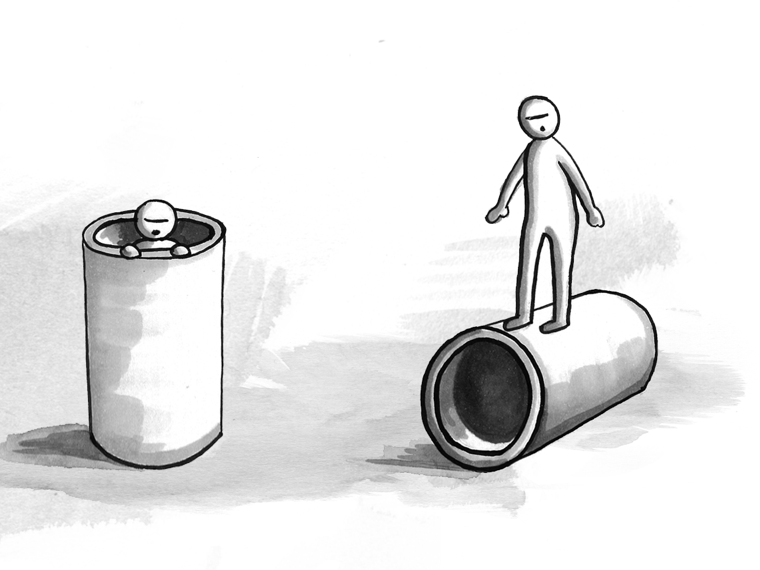FACILITATION AND LEGO SERIOUS PLAY
Do adults need a different approach or role in facilitation?
I believe adults can have strong and developed perspective on certain challenges, and bring a lot of prerequisite knowledge. This can be seen as expertise, but when you are looking for unexpected new results or insights, the usual way of thinking is not really what you want. Kids, on the other hand, are much more inclined to go into the tinkering process with an open mind and ready to experiment.
I would say that this difference requires a different approach in facilitation. Where with kids, the focus is more on practical matters, assisting, and perhaps keeping the tinkering on-topic, adults might require a bit more help opening up their perspectives to allow for unexpected outcomes.
Some important concepts for facilitation I got from LEGO Serious Play:
1. The facilitator should make way for constructive reflection and dialogue by showing curiousity and asking questions.
2. The facilitator should always represent the common basic values of the group, creating a safe environment.
3. The facilitor should only focus on guiding the process, not the outcome.
PAPERT AND MONTESSORI
Papert's key principles in summary:
1. Learn by doing something you find interesting or making something you want.
2. You can learn a lot from using technology, as you can make more interesting things. Especially computers are good for this.
3. You learn best when you both enjoy what you are doing, and are challenging yourself.
4. Take charge of your own learning. Learning doesn't come exclusively from teaching.
5. Take the necessary time to learn.
6. Failures are learning opportunities.
7. Acknowledge that (as a teacher) you are not teaching, but also a participant in the learning.
8. Technologies (like computers) are becoming more important.
A summary of Montessori's key principles, based what I could find online:
1. Respect for the child. Each child is unique, and should be given the freedom to guide its own learning process.
2. The absorbent mind. Young children are naturally curious and learn very easily, and this should be fostered through a stimulating environment.
3. Sensitive periods. Learning should be tailored to the specific phase of life a child is in, as they have a greater ability to learn certain things.
4. The prepared environment. The learning environment should be set up with the purpose of pushing children to learn independently and explore.
5. Auto education. Children are able to teach themselves. Teachers are for providing support.
The two approaches are similar in that they both name that learners should take initiative with the learning process. Additionally, freedom as a key principle of Montessori could be considered connected to the interest and enjoyment principles of Papert. Students in a Montessori school would be naturally inclined to satisfy these principles and chase curiousities because of the freedom they're given.
The fundamental difference between the two approaches seems to be the freedom in choosing what to learn about. As I understand it, Papert wants students to take charge of their learning process when presented with a somewhat predetermined curriculum, where Montessori says not to give directions, and allow the student complete freedom in picking something to learn themselves, presented to them by the learning environment.
Montessori seems to have quite some specific ideas related to teaching young children, but I do not recognise the same in Papert. All I get out of his key principles is that he seems to suggest that children of our generation should be learning about computers, because they are useful and important.
SPACE
Some useful pointers for a tinkering space or setting I got from Invent to Learn:
1. Make the tinkering space look different or stand out from a "regular" space.
2. Different people have different styles and approaches. Accomodate for this variety.
3. Opportunity for documentation of the tinkering process should be provided and easily accessible.
4. Flexibility in the organisation of the space is important to allow for unexpected forms of collaboration.
5. Displaying examples in the space is good for inspiration, but, be mindful when showing complete projects, as it might intimidate learners.
6. Make complex tinkering tools accessible. Everyone uses technology for assistance.
7. Support independence by putting a focus on safety and security. Tinkerers should feel comfortable exploring new tools and materials.
8. Provide storage for projects.
A DesignLab or FabLab is not strictly necessary for tinkering, as the example of Josh Burker shows that a portable tinkering environment can still be effective at creating tinkering experiences. However, a facility dedicated to tinkering is of course very convenient, and perhaps able to facilitate more effective tinkering.
MY PROCESS
I usually like to tinker when I do not know how to progress further in a project. Sometimes the next step for improvement is not so clear anymore, and then tinkering helps me explore the problem space and find things to work on.
When I feel stuck there are a few things that tend to help me.
I might try changing my environment. I force myself to move around a space a bit, or even go outside. It helps me leave certain thought for a bit and perhaps get inspiration from new stimuli in a different environment.
Alternatively, I might take a short break or allow for some distraction. Similar to the changing of spaces, by allowing for very different stimuli to come in for a change, I feel like I can come back a bit more refreshed.
Probably my favorite way to deal with feeling stuck is talking to someone else about the problem. Preferably someone who is not closely involved with the project. Someone else's fresh perspective can really help break free from some old assumptions or thought patterns. Ive heard the term 'rubber duck debugging' being used for this.
The most effective way for me to get into a 'flow', is by making sure I feel rested and otherwise healthy. My skills are most effective when I've had enough sleep, and the same goes for my ability to mentally push when a task gets challenging. Other than that I suppose that I want to feel somewhat comfortable in the moment, to allow me to focus my full attention at the task at hand.



